The Mosel river is a picturesque waterway that originates in the Vosges mountains of France.
There it is known as the Moselle river as it meanders through northeastern France and before it eventually crosses the border with Luxembourg and Germany.
The greater length of the river lies in France (just over 310 kilometres) but more people are aware of the German section, which is famous both for its Mosel valley wine and for its lovely villages and castles along the banks of the river.
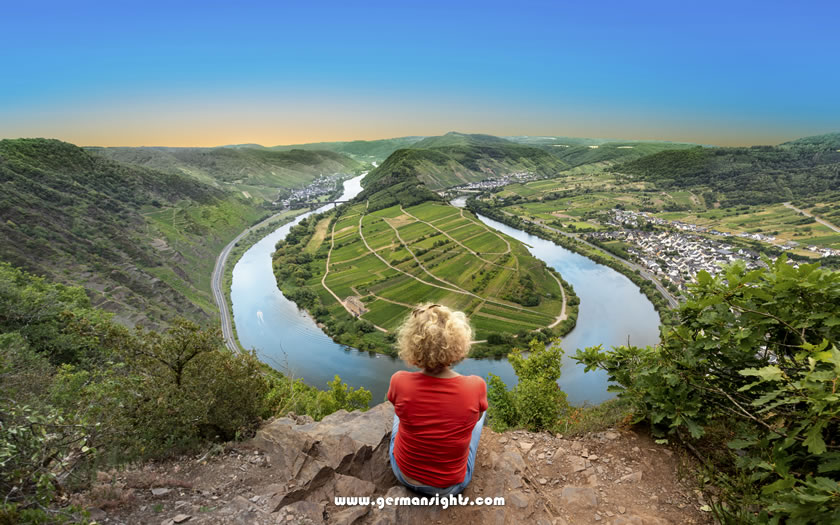
One of the scenic 'loops' in the Moselle valley
The Mosel finally merges with the Rhine river at Koblenz after nearly 550 kilometres.
This region has a rich history, having been cultivated by the Romans centuries ago. Today, the hillsides along the Mosel are adorned with terraced vineyards that produce some of the finest Riesling wines.
Adding to the allure are numerous castle ruins standing proudly atop hilltops overlooking charming wine villages and towns.
The Mosel river has been a crucial corridor for trade and travel since ancient times.
The Romans played a pivotal role in shaping its history. They established the city of Trier around 2000 years ago, making it one of Germany's oldest cities. They planted the first vineyards along its steep banks of the river, which was important for the wine trade.
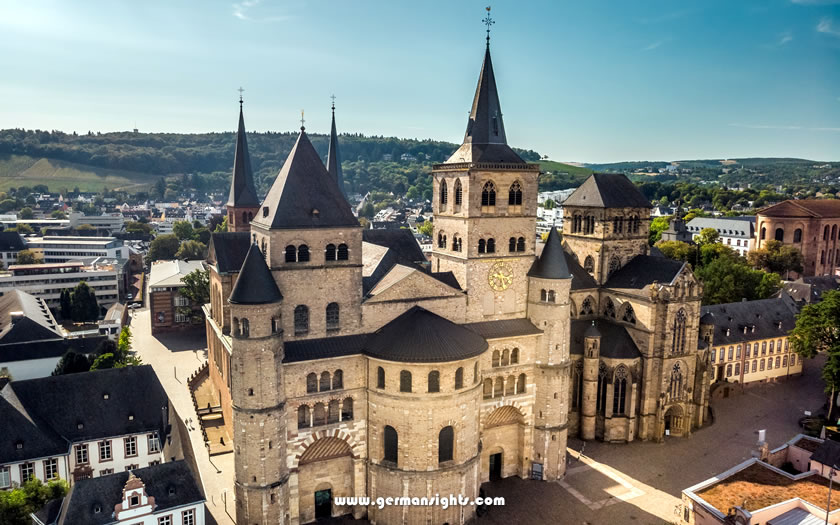
Trier cathedral
During the Middle Ages, the river was vital for commerce and transport, with many settlements, such as the town of Cochem, springing up on its banks.
Castles such as Reichsburg Castle in Cochem and Burg Eltz near Koblenz bear witness to these times, built for both protection and as a sign of wealth and power.
The Mosel region underwent significant changes during the Industrial Revolution, as it became more connected with rail and roads. Some areas along the Mosel, particularly Trier and Koblenz, suffered from heavy bombing during World War II.
Post-war reconstruction and modernisation have brought prosperity. Today, the Mosel river region is known for its wine production, beautiful landscapes, and rich historical heritage.
If you know when you are planning to go but haven't decided on accommodation, then use the searchbox below to get an idea of which properties are available and to compare prices during the period you wish to travel.
The German part of the Mosel is often split into three sections.
The Upper Mosel ('Obermosel') is really a geographical nonsense as technically speaking this should refer to sections of the river further south in France.
However, the term is used to describe the section of the river between the French border through to a point just south of the city of Trier. The river forms the border between Luxembourg and Germany for around 40 kilometres.
The soil here is a type of limestone not found near the rest of the river and so a higher proportion of the wines produced here are made with other kinds of grapes, such as the Pinot Blanc or Pinot Noir varieties, rather than the more common Riesling.
The Middle Mosel ('Mittelmosel') section of the river starts at the city of Trier and stretches through to Riel. This is the principal area for wine production and is where some of the best-known Mosel wines come from. The rock here changes from the limestone of the Upper Mosel to vineyards constructed on steep slate river banks with Riesling being the principal grape harvested.
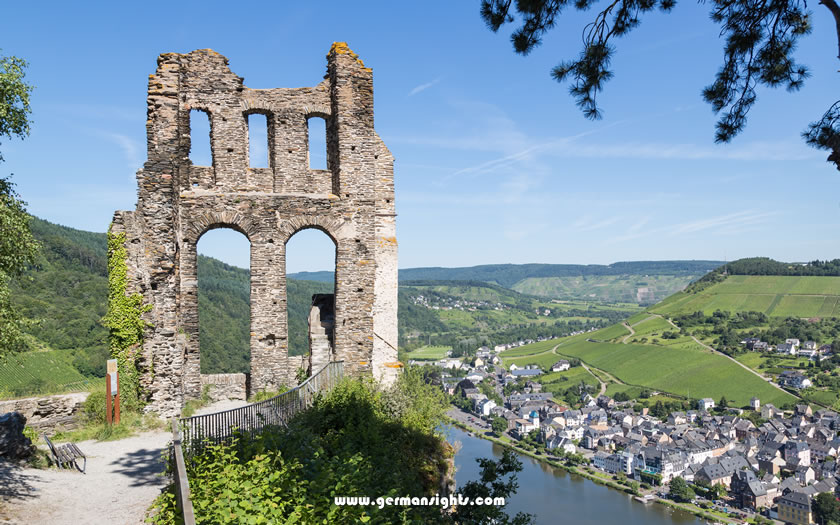
The ruins of Grevenburg castle in the Middle Mosel region
The river itself meanders in great loops with smaller villages on either bank. The names will be familiar to fans of German wines. Piesport, for example, and Bernkastel-Kues are two traditional villages surrounded by renowned vineyards.
The Lower Mosel ('Untermosel' or 'Terrassenmosel') region stretches from Pünderich through to the Rhine river at Koblenz.
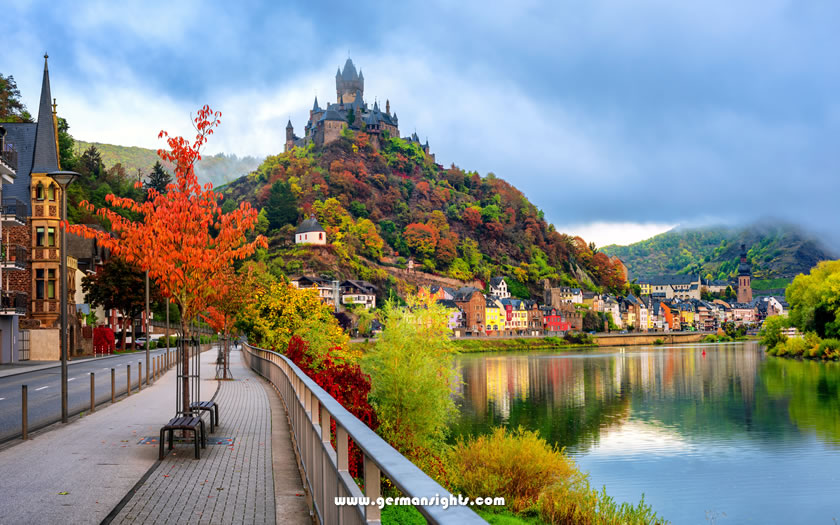
The Mosel promenade in Cochem
Villages and towns along the way include Zell, famous for the 'Schwarze Katz' ('Black Cat') brand of wine which is mostly exported, and the picturesque town of Cochem, with Cochem Castle perched on the hill above the houses.
Here the steep vineyards on the banks are even more difficult for the winegrowers to harvest. Many of the smaller operations have gone out of business in recent years.
There are plenty of towns and villages (and even cities) to choose from if you are planning a break in the Mosel valley. Here are four of the best options if you are looking for a base to move around from and some points of interest in the location itself.
Trier is celebrated for its well-preserved Roman architecture, making it a historic gem in Germany. The city is home to the legendary Porta Nigra, an imposing monument that has stood since Roman times.
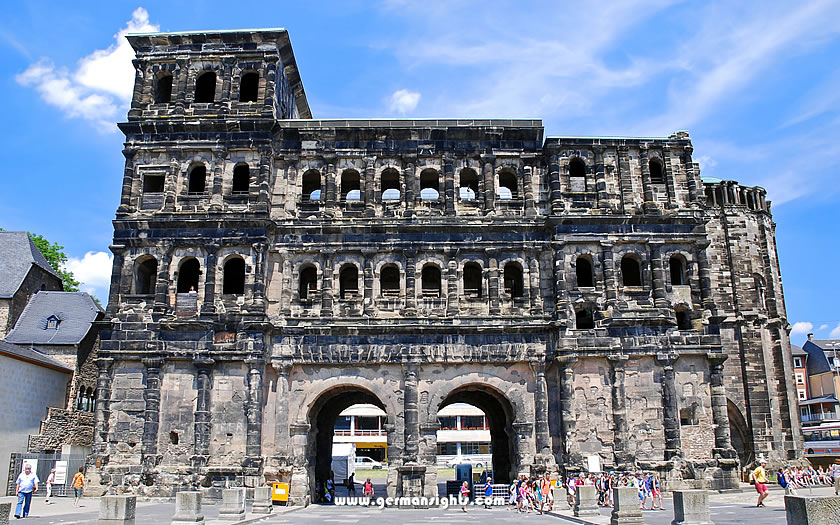
The Porta Nigra in Trier
History enthusiasts can dive into the city’s rich past at the Rheinisches Landesmuseum, which houses a vast collection of Roman antiquities.
Bernkastel-Kues is a famous wine-producing area in the Middle Mosel. It is also a popular stop for anyone doing a tour of the Mosel valley because of the attractive timber-framed houses in the centre of the town.
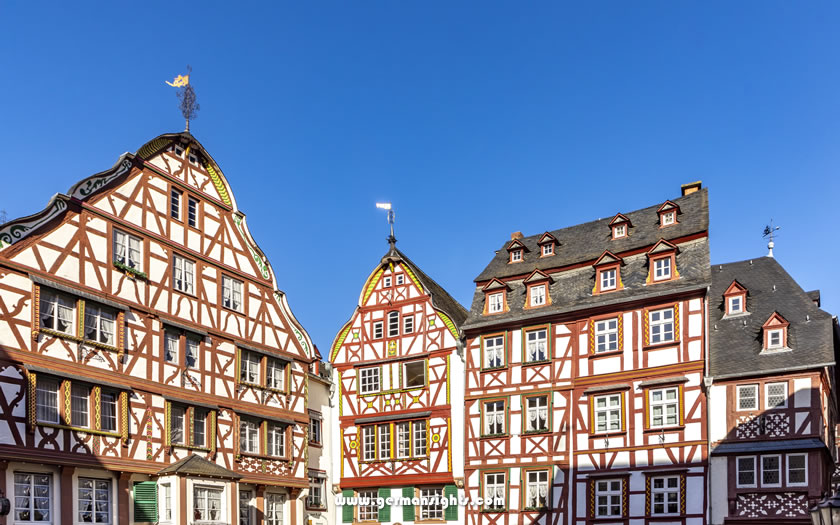
Half-timbered houses in Bernkastel Kues
More energetic visitors can hike up to the ruins of Landshut castle high above the town for a spectacular view over the vineyards and river.
Cochem is renowned for its picturesque setting in the Moselle valley. The town’s most notable landmark, Cochem Castle, stands majestically on a hill above the town and dates back to 1000 AD.
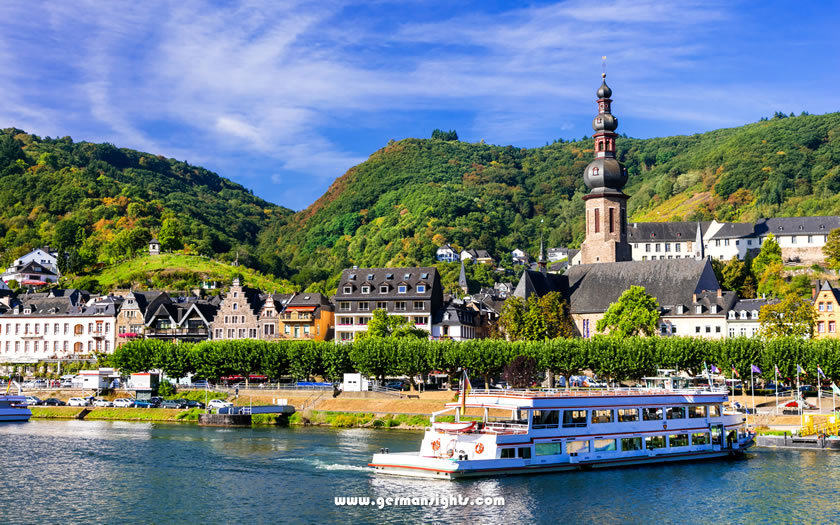
River ferry at Cochem
Visitors can ride a chairlift up to a spectacular view over the castle and surrounding countryside or wander through the charming old town with its half-timbered houses.
Koblenz marks the end of the Mosel and is the point where it joins the river Rhine. The actual location is a famous German landmark called the 'German Corner' (the 'Deutsches Eck'), marked by a statue of Emperor Wilhelm I.
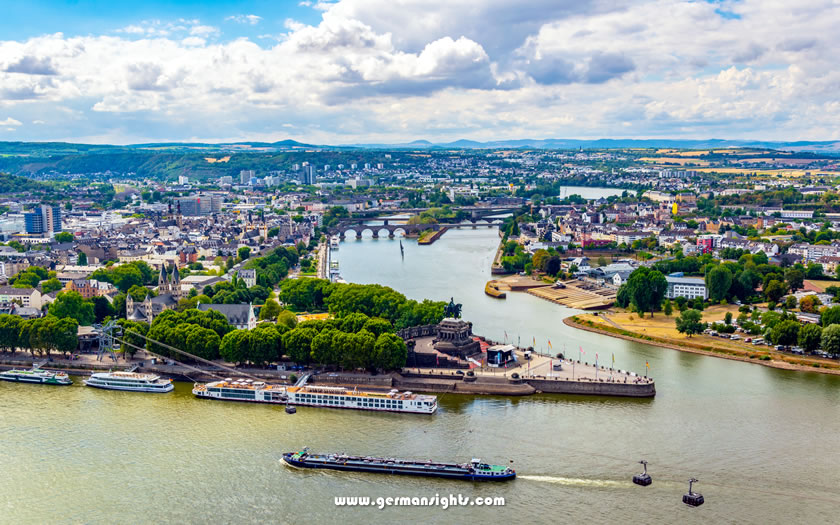
The Mosel river joining the Rhine at the German Corner
The city’s rich history can be explored in its Old Town and the impressive Ehrenbreitstein Fortress on the other bank of the river Rhine.
Cochem is known for its castle, Reichsburg Cochem, literally 'Cochem Imperial Castle'. This castle perched on a hill overlooking the river is a must-see attraction with its breathtaking views of the surrounding vineyards and valley.
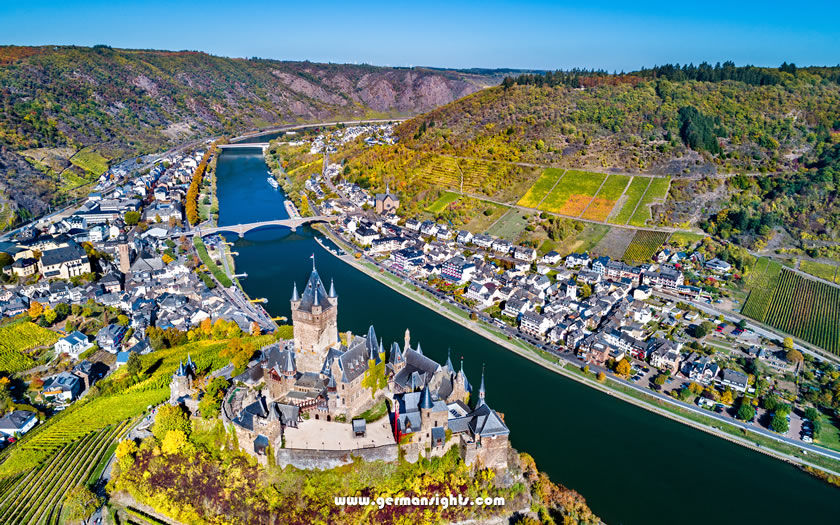
Reichsburg castle at Cochem
The original Cochem castle was destroyed in the 17th century and only rebuilt in the late 19th century. Remains of the original medieval building can still be seen in the walls and towers of the restoration.
Reichsburg castle can be viewed on guided tours in the summer months. (There is a limited programme of guided tours in the winter months.) It can be reached either on a footpath or by using a regular shuttle bus from the town centre.
Burg Eltz is located a little further down the Mosel from Cochem towards Koblenz.
The castle is located a short distance away from the Mosel river in an elevated position in the Eltz side valley. It is most easily reached from the town of Wiersheim.
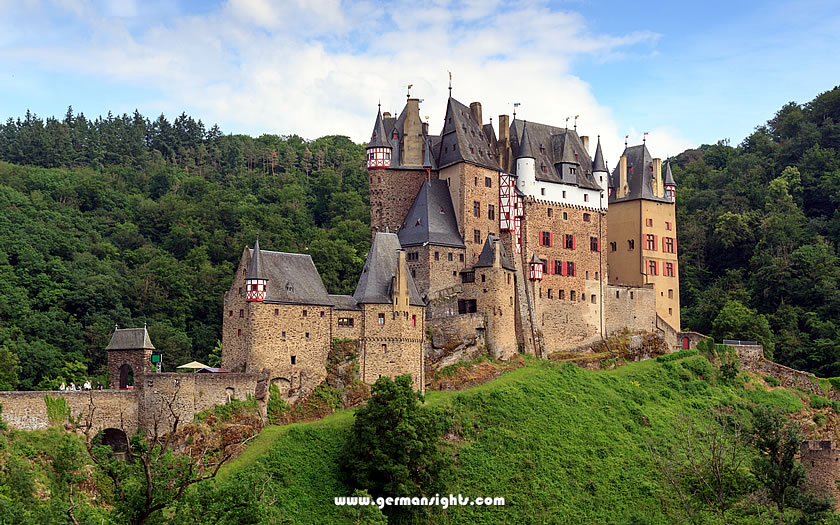
Eltz castle near the Mosel valley
Eltz castle was originally built back in the 12th century and the medieval castle was shared between different members of the family. It was located on a trade route from the Mosel valley into the Eifel mountains.
It was restored in the 19th century and again between 2009-2012. It is a private residence still owned by members of the Eltz family but can be visited during the summer months on guided tours.
Those who are a car will have few problems exploring the towns and villages along the Mosel river. From just north of Trier, B-roads (particularly the B-53 and B-49) follow the course of the river all the way through to Koblenz.
Public transport is also relatively easy in the valley. The train service does not cover every town and village, but enough places along the river have rail connections to make the train an option for moving around the valley. There are also local bus services which serve locations which may not have a train station.
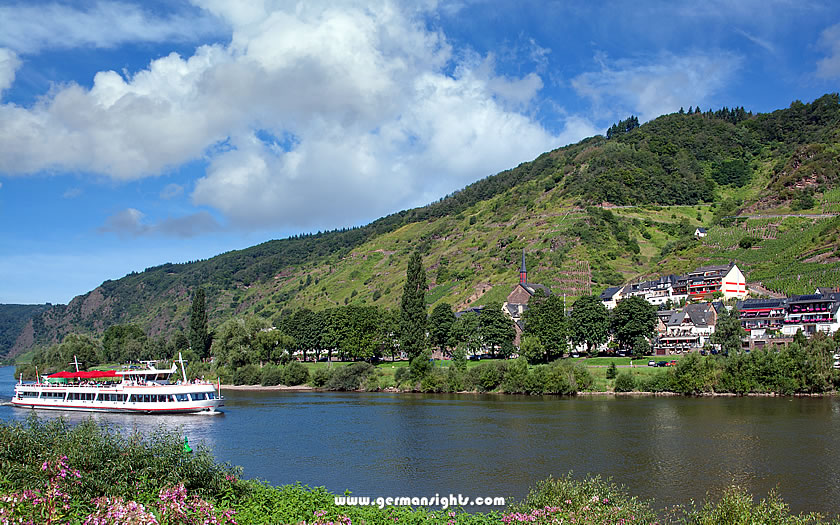
Taking a river cruise on the Mosel
Another option is to use the river cruise boats to travel up and down the valley. The stretch of the Mosel between Trier and Koblenz is covered by a network of boat services which are often used for return day trips, but which can equally well be used to travel up or down the river to the next destination while enjoying the landscape along the way.
Those who are using public transport might want to consider using Cochem as a base, as it has good connections on rail, road and water.
One option for those seeking a more active way to explore the Mosel valley is the Mosel Cycle Path.
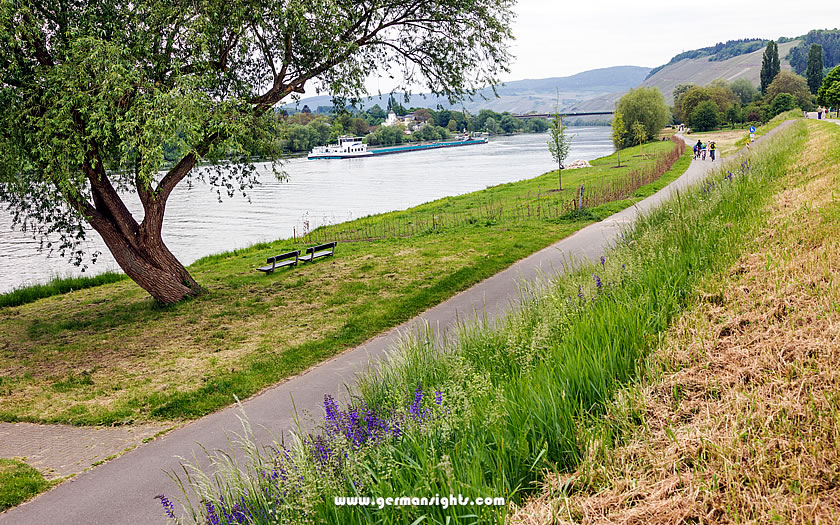
The Mosel valley cycle trail
This stretches 248 kilometres from the French border through to Koblenz and is generally split up into 10 stages of between 20 and 25 kilometres.
The cycle path is considered to be an easy route without any major climbs and is recommended for those considering their first long-distance cycling trip.
Something a little more strenuous would be the Moselsteig Hiking Trail.
This takes the same stretch from the border to Koblenz as the cycling trail, but is a little longer because it strays onto the hills and ridges above the river.
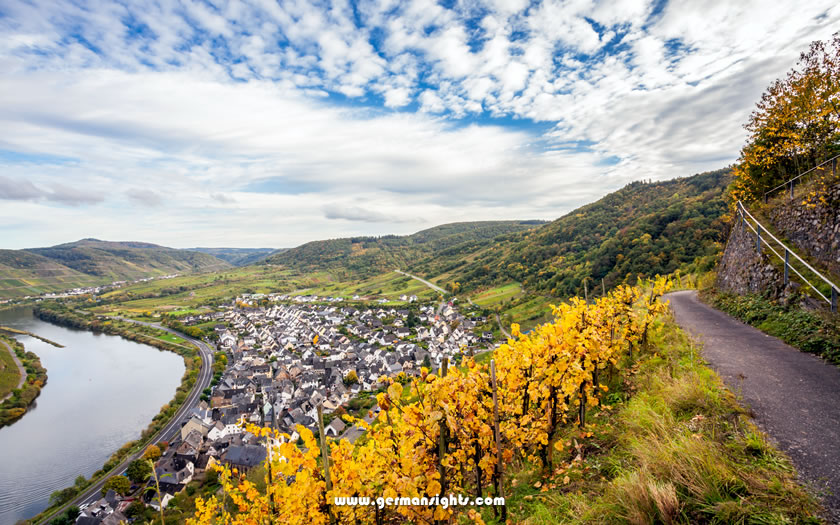
Hiking in the Mosel valley
The total length of the trail is 365 kilometres split into 24 stages. As with other long-distrance walking routes, many hikers tend not to do the whole trail in one go.
One advantage of splitting it up over various breaks is the ability to take advantage of the many circular hikes that can be accessed along the way. They are marked as 'Side Trails' (or 'Seitensprünge' in German) and are a way to stay a couple of nights in a location and explore the points of interest around it.
One of the best resources for further research, especially for the cycling and hiking routes listed above, is the official VisitMosel regional tourist office:
Website: en.visitmosel.de